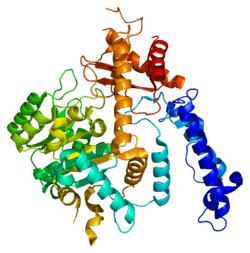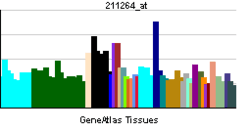GAD2
| View/Edit Human | View/Edit Mouse |
Glutamate decarboxylase 2 is an enzyme that in humans is encoded by the GAD2 gene.[3]
This gene encodes one of several forms of glutamic acid decarboxylase, identified as a major autoantigen in insulin-dependent diabetes. The enzyme encoded is responsible for catalyzing the production of gamma-aminobutyric acid from L-glutamic acid. A pathogenic role for this enzyme has been identified in the human pancreas since it has been identified as an autoantibody and an autoreactive T cell target in insulin-dependent diabetes. This gene may also play a role in the stiff person syndrome.[4]
Interactions
GAD2 has been shown to interact with GAD1.[5]
See also
This article incorporates text from the United States National Library of Medicine, which is in the public domain.
References
- ↑ "Human PubMed Reference:".
- ↑ "Mouse PubMed Reference:".
- ↑ Cram DS, Barnett LD, Joseph JL, Harrison LC (July 1991). "Cloning and partial nucleotide sequence of human glutamic acid decarboxylase cDNA from brain and pancreatic islets". Biochem. Biophys. Res. Commun. 176 (3): 1239–44. doi:10.1016/0006-291X(91)90418-7. PMID 2039509.
- ↑ "Entrez Gene: GAD2 glutamate decarboxylase 2 (pancreatic islets and brain, 65kDa)".
- ↑ Dirkx R, Thomas A, Li L, Lernmark A, Sherwin RS, De Camilli P, Solimena M (February 1995). "Targeting of the 67-kDa isoform of glutamic acid decarboxylase to intracellular organelles is mediated by its interaction with the NH2-terminal region of the 65-kDa isoform of glutamic acid decarboxylase". J. Biol. Chem. 270 (5): 2241–6. doi:10.1074/jbc.270.5.2241. PMID 7836456.




